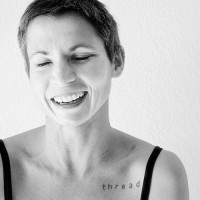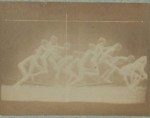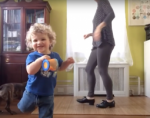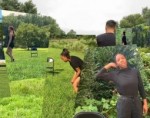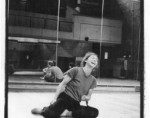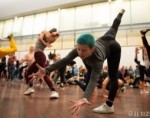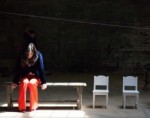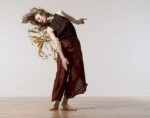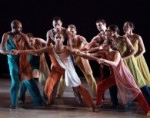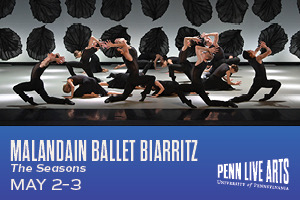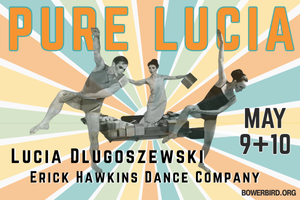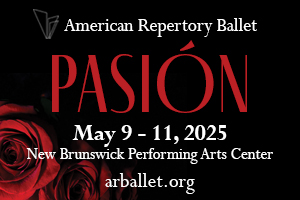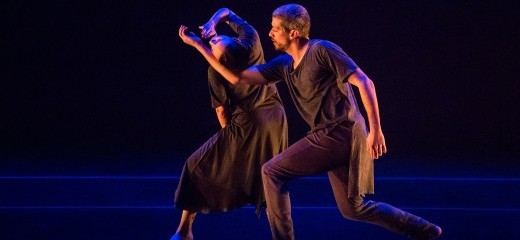
Writing Together about the Come Together Festival
By Lynn Brooks, Kirsten Kaschock, and Lisa Kraus
One of the advantages of a showcase or festival-style summer series is that you get to scan a lot of work by different choreographers and companies to discover who and what speaks to you—or leaves you wishing you were elsewhere. It’s also an opportunity to explore what draws different dance-goers to their seats. Three thINKingDANCE writers share their experiences of the 2015 Come Together Dance Festival, two as audience members and the third as a post-show discussion leader.
Kirsten Kaschock, on the House and the Show, July 25
The Suzanne Roberts theatre was packed. The audience—an eclectic mix of patrons, students, and members (and veterans) of the dance community—arrived early for happy hour, their mood celebratory.
Young dancers of The Rock School took the stage first (in three Petipa variations and two contemporary works). Their impeccable technique laid the groundwork for performances both engaged and assured. Mackenzie Brown’s fawn-like extensions and effortless precision floored me.
When the lights went up on 10 Hairy Legs, there were in truth only six. This trio of men in a tub (a prop, not a metaphor) offered tableaus coy and frontal and all about equal opportunity objectification, while mining the intersection of athleticism and wit. The Beethoven score choreographer Cleo Mack chose heightened the irony of dancers aggressively displaying themselves to the audience yet remaining oblivious to the potential of onstage partnerships.
Melissa Rector and Raphael Xavier’s works followed. Rector (Assistant Artistic Director of Koresh and longtime company dancer) created a duet where one woman eventually replaced another centerstage as if offering her a break from repeated gestures of frustration and futility. Between a series of tongue-in-cheek interludes, Xavier’s quartet of breakdancers (including himself) powered their movement with diverse styles and strengths. When, after Macca Malik’s solo of hand spins and a final feisty posturing, the audience cheered wildly for her, the three men all but rolled their eyes as if to say, “Again?”
The next three companies—Philadanco, Kun-Yang Lin/Dancers, and Koresh—are Philadelphia staples, and although the vision each brought to the stage was unique, there was commonality: the dancers’ confidence in each other and the work created micro-worlds that pulled the audience into them.
Risk can only be taken repeatedly when there is trust. Philadanco’s six-person Latched, choreographed to a Sohn song with the repeated lyrics, “If you’re thinking of letting me go then maybe it's time that you do,” offered the desperate sadness and angry drama of good break-up sex. Progressive duets had dancers uniting and parting at breakneck speed and with unrelenting purpose without sacrificing particularity (even in their sleek, unisex black turtlenecks and jazz pants). In the intriguing HOME/S. 9th St., Kun-Yang Lin/Dancers (six dancers in similar white outfits) serendipitously presented a near inverse image of Philadanco, with entirely different motivation. Their risk was in gentle absurdity, in childlike vulnerability—dancers clinging to one another’s legs or progressing across a row of chairs as if to create an imaginary journey out of household items.
By the time Koresh Dance Company finished the program with selections from Promises I Never Meant to Keep—the whole company, often in tight unison, performing Koresh’s signature modern-jazz vocabulary and folk-dance inspired sections—the audience was primed for the choreographic invocation of solidarity. When the dancers paired off, it was refreshing to see a female duet take center stage.
Ronen Koresh dedicated this performance to Suzanne Roberts’ late husband. Mrs. Roberts sat in the audience a few seats away from me; when she stood, she was beaming. What better use of a house than to bring people together within it?
Lynn Brooks on the Closing Festival Night, July 26
Attending this evening of the festival assured me that there are plenty of accomplished dancers in Philadelphia, and a few interesting choreographers as well. Because a lot of the work presented that evening was hard-hitting, percussive, group dancing to driving music (all recorded, and all projected way too loud—a seatmate had her hands over her ears at times), the work that fell outside of those descriptors stood out to me. For example, the show opened with JUNK presenting excerpts of Brian Sanders’ American Standard, danced to country-western music. The straw-strewn stage was dominated by a pelt-covered artificial bronco and the five dancers had a ball exploring it, one another, and the rhythmic foot-slapping of old-timey dancing. There was plenty of acrobatic virtuosity—a JUNK hallmark—but not only that, and all in service of the consistent and winning Western/cowboy theme.
A company I’d never seen before, idiosynCrazy productions, also impressed me with its textured exploration of togetherness and individuality. The piece they presented, Shannon Murphy’s Conditional, just went on too long, however, even with these beautiful and utterly committed dancers. Still, I’ll be on the lookout for their shows in upcoming seasons.
Much of the other work in this closing evening was very busy, for my taste, with too many people doing too much movement, too fast and hard, for too long. Thus, Kat J. Sullivan’s work, second in the program, offered a welcome calm and meditative performance quality unmatched by the evening’s other work.* Sullivan’s spare rigor in Reign, performed sensitively by Meredith Stapleton and the choreographer, gave the audience room to enter and inhabit the mysterious world of these partly naked, partly overdressed royals.
The evening—and, thus, the festival—closed with the virtuosic Koresh Dance Company in three works by Ronen Koresh. Change, La Vie en Rose, and Bolero were presented in immediate succession, although it wasn’t clear if they were three entirely separate works, or intended to be seen as some kind of suite.
The coming together of these different companies brought their individual styles (including hip hop, modern, lyrical, and ballet) up against one another—no surprise in this age of fusion, but nice to see, nonetheless. The audience seemed to think so, too, lustily cheering on the dancers, then exuberantly greeting them as they appeared in the lobby at intermission or post-show—many spectators clearly there, initially, to support their friends or family members. And that’s a good thing, both the support and the exposure beyond whichever person or group drew each of us to attend. We got to see the big, broad world of Philadelphia dancing.
Several of the festival evenings featured Philadelphia dance leaders moderating post-show talk-backs.
Lisa Kraus, on Post-Show Talks, July 24
How do you talk meaningfully with nine choreographers in a 20-minute post-show chat? Invited to lead one of these talks during the Come Together Festival, I wondered how to see a slew of pieces for the first time and, immediately afterward, engage meaningfully with each maker in front of an audience. It takes me time to digest what I’ve seen. So I came up with open-ended questions about process that I might pose to just about anyone:
What was your starting point?
What question would you like to ask the audience about how they saw your work?
What was challenging about making this dance?
How does this dance relate to tradition: adhere to it, take off from it, stretch it?
What aspect of this dance most excites you?
Is there particular training involved with performing this dance?
Do the dancers have any role in creating their own parts?
How do you think about music’s relationship to movement in this dance?
Then I came up with some questions just for fun:
If you consider the other works on this evening, which choreographer can you imagine yourself collaborating with?
Which dancer would you like to swipe to be in one of your dances?
As the moment drew closer, all this seemed too complicated. When an evening is made of disparate kinds of dance, I think it can be interesting to hear the varied artists responding to the same question. So I asked:
What does this piece bring forward from your earlier work and what in it is new for you?
This promised to get people to reveal what they value in making a dance and where their frontier lies for exploration. In fact, it became the dance makers’ springboard for addressing their work in their own ways.
Roni Koresh, whose almost 25-year-old company initiated and runs the festival, spoke about not looking for originality in movement per se at this point, but being more interested in finding something compelling in how he is putting it together. This was echoed later in connection with Rennie Harris’ innovation of taking hip hop onto the concert stage within theatrical frameworks. It turns out that this development owed a debt to Koresh, too. Early on, Harris witnessed Koresh’s work and took classes at his studio, helping cultivate his compositional savvy. Kyle Clark of Just Sole: Street Dance Theater, in the Harris lineage, talked about honesty as a value, and about the work the group is doing with youth (their company is indeed full of talented young dancers).
Matthew Soojian, who showed a tap trio, said he was excited to make a pure tap dance—his first. Others spoke about the origins of their work. Diane Sharp-Nachsin related how her piece was developed on a Greek island through a visionary dream her dancer had. Tara Madsen Robbins told how her women’s duet was created while getting her MFA and has since been performed by multiple, changing casts. Lauren Putty White spoke about her work as a response to recent violence against blacks, equating this violence with humans’ animal nature.
Anne-Marie Mulgrew’s quintet on this show was especially lyrical. An audience member asked the Philly dance-scene veteran how she “keeps on keeping on,” recognizing her as an inspiration. All the artists expressed appreciation for the opportunity to show work in this festival focused on community, audience development, and cross-pollination.
For those who could extend their involvement beyond watching the performances and participating in the post-show chats, the festival also included several master classes in styles identified as breaking, Indian, modern jazz, contemporary ballet, and hip hop; pre-show happy hours; and a closing-night party. Now that’s festive!
* Full disclosure: during her years studying at Franklin & Marshall College, Sullivan was Lynn Brooks’ student.
Come Together Dance Festival, Koresh Dance Company, Suzanne Roberts Theatre, July 22-26.
By Lynn Matluck Brooks
August 3, 2015



